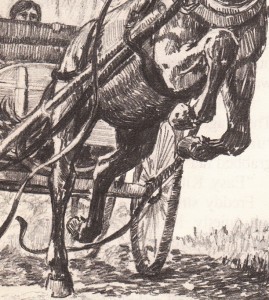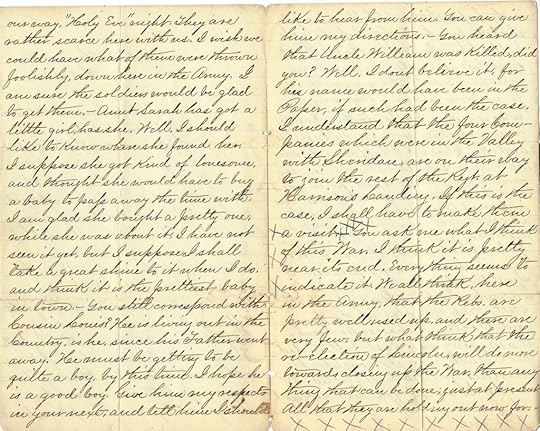Kathy Lynn Emerson's Blog, page 73
June 8, 2016
A Serious, But Seldom Discussed Maine Issue
John Clark discussing an important, but seldom talked about issue in Maine. At a time when the population is getting older, our state department of transportation has shut down at least four rest areas on I-95. The two just north of Augusta and the two just south of Pittsfield are no more. Good thing there’s no truth to the two Maine theory because all four are north of what I consider to be the imaginary line dividing those two Maines that don’t exist.
Granted, as a guy, I can pull over in any rural area when the call of nature strikes (something that happens more when you get to be my age, alas), but that’s not particularly true on the turnpike or I-95. In fact the last time I did so, A state cop pulled up and quizzed me about my intentions. Heck, even the Airline has more pit stops than the interstate now. As for women, the stop and relieve option isn’t one often considered.
This brings me to an idea that’s been floating around in my head for a while. In an era where corporations are eager to purchase naming rights to arenas and stadiums, why not sponsored rest areas. It’s been done in Arizona, Florida, Iowa and Virginia in various ways already. I’m here to promote the concept and suggest a few potential candidates. I welcome your added sponsors and slogans in the comments section.
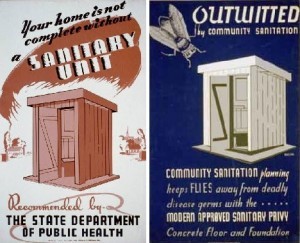
From a time when government cared
Depends is a natural with the “We’ve got you covered, no matter where you’ve gotta go,” welcome sign. Tim Horton’s would be another (providing Dunkin Donuts or Starbucks don’t scoop them) with dual offer of relief and a discounted recharge to keep folks going until they can’t. Then there’s Maxwell House, proclaiming their rest area is “Good to the Last Drop.”
Nike would be perfect with their “Just Do It” campaign, while even Hallmark might have an interest in sponsorship with their ‘When You Care Enough to Send the Very Best.”
I suspect there might even be a sponsorship battle between the ED moguls given the slogans “It Ain’t Gonna Fix Itself,” and “Freedom to be Ready and Relaxed.” Other drug companies are definitely in the running. Consider Alka-Seltzer’s timeless slogan “Plop, plop, fizz, fizz, oh what a relief it is,” or Rolaids “How Do You Spell Relief?”

Who wouldn’t want to sponsor something like this?
Soft drink giant Coke is another possibility with “The Pause That Refreshes,” then there’s Mastercard. Imagine a rest area proclaiming “There are some things money can’t buy. For everything else, there’s MasterCard.”
Even the political parties are liable to get in on the action, depending upon which one comes up with the best take on the trickle-down, not to mention the possibility of Microsoft getting in on the act by grabbing all rest area sponsorship sites, thus answering the question posed in their ad slogan “Where do you want to go today?”

Imagine something like this on the horizon when ya gotta go (this is a real rest area from Europe)
How about the tourism industry, starting with Holiday Inn. Imagine pulling in when you’re at the end of your rope to be greeted by a sign saying “Pleasing People the World Over.” Even major cities can get in on the act, beginning with Las Vegas and “What Happens Here Stays Here.”
Last but not least is Home Depot with their greeting at the rest stop south of Lincoln “You Can Do It, We Can Help.”
I bet some enterprising and creative readers can come up with even better corporate sponsors. Feel free to share them in your comments.
June 6, 2016
The Waldoboro Public Library
Dorothy Cannell: Some years ago I was talking with a friend who had moved to the U.S. from England as an adult, as I had done. Our conversation revolved around the strong pull that the country of our birth and upbringing still had upon us both.
“But how much is nostalgia?” She mused. “Our England was rooted in the forties and fifties. That world is gone; but we’re left wanting the village – the thatched cottage next door to Miss Marple.”
In my case there had never been the village or cottage thatched or otherwise; the reality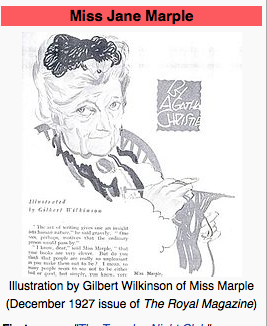 had been an ordinary town with nothing picture post card about it, but there had been Miss Marple met during my early forays in reading mysteries. For me one of the wonders of fiction is that it took me from an early age to places that I could weave into my reality in the sense of their becoming part of who I am. The vast majority of the books I read during my childhood came from the library where I went almost every Saturday afternoon with my father. Those memories instilled a lifelong love of libraries. For the availability they provide of catching a magic carpet ride to a thousands of destinations I might otherwise never visit, I am deeply grateful.
had been an ordinary town with nothing picture post card about it, but there had been Miss Marple met during my early forays in reading mysteries. For me one of the wonders of fiction is that it took me from an early age to places that I could weave into my reality in the sense of their becoming part of who I am. The vast majority of the books I read during my childhood came from the library where I went almost every Saturday afternoon with my father. Those memories instilled a lifelong love of libraries. For the availability they provide of catching a magic carpet ride to a thousands of destinations I might otherwise never visit, I am deeply grateful.
When my husband Julian and I moved to Maine in 2004, I had a sense of coming home. In England whether in town or village, one is never far from the sea and much as I had enjoyed living in the mid-west I had felt landlocked. Here I additionally felt restored to a simpler time, before life became so fiercely busy that the days get eaten up without the opportunity to savor their aroma let alone taste them. A place where community still matters, sustaining and enriching within the wide range of happenings between festivals or funerals.
These thoughts are in the forefront of my mind because last Saturday I participated in an open house celebrating the centennial of The Waldoboro Public Library. I had not been to Waldoboro previously, but once turning from Route 1 onto Main Street there was again that tug of familiarity, the recognition of Maine’s small town variation of an English village. A location where people’s lives intertwine with those of their neighbors, their past and their present.
I arrived a little early because afraid of getting lost enroute. Other authors (including Lea Wait) and local celebrities were present. There was a loaded table of wonderfully good things to eat supplied by volunteers, but it was the warmth and cheerful excitement of celebrating a majorly important anniversary of Waldoboro’s history that encouraged me to ask if there was a booklet regarding the establishment of the library and it’s growth that I could take
 Here are some excerpts from The Waldoboro Public Library 1916 to 1983.
Here are some excerpts from The Waldoboro Public Library 1916 to 1983.
‘In 1916, a group of Waldoboro residents met formally and set up the procedure for answering what they saw to be Waldoboro’s need for a public library.
‘In the beginning, the books that were to form the core of the collection were gathered from personal libraries, donated by local institutions, purchased with money given by local groups and individuals, thus forming a truly representative collection of books, which people enjoyed, considered useful, or wished to consult. It is a concept that once pervaded all libraries and that is seen most clearly in small libraries in which every dollar spent on books must be turned twice in order to get the community’s money’s worth.’
‘As with most libraries, the policies and the patrons adjusted to each other by degrees – hours changed and changed again, emphasis went back and forth between educational and recreational usage. Policies, which were to continue into tradition, began and grew. The use of a pay shelf (with a charge of two cents a day in 1918) for the latest best sellers, the two-librarian system in 1967 on the retirement of the redoubtable Sarah Lash who had been the librarian for 37 years, the volunteer nature of much of the work of running the library.’
Here’s my favorite:
‘The Waldoboro Library it was and the Waldoboro Library it would remain – heavily used, often overcrowded, wistfully dreaming of bigger things.’
I like that – Change walking arming in arm with the Past into the Future.
Happy reading,
Dorothy
June 5, 2016
The Story Behind A Story
Kaitlyn Dunnett/Kathy Lynn Emerson here, once again writing about my grandfather, Fred Gorton of Liberty, New York, last seen in “The First RFD Carrier in Town” This post also has to do with me and my writing.
Grampa wrote his memoirs when he was in his eighties. I used some of the stories he told about growing up in the 1880s early in my career when I wrote a children’s book for ages 8-12, Julia’s Mending, but it was a story of his from 1910 that ended up inspiring one of the first pieces of short fiction I ever had published.
There are two versions of events, the one in the newspaper at the time and Grampa’s account written years later. Here’s what the newspaper reported:
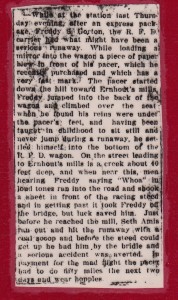 While at the station last Thursday evening, after an express package, Freddy S. Gorton, the R. F. D. carrier, had what might have been a serious runaway. While loading a mirror into the wagon a piece of paper blew in front of his pacer, which he recently purchased, and which has a very fast mark. The pacer started down the hill toward Ernhout’s mills. Freddy jumped into the back of the wagon and climbed over the seat. When he found his reins were under the pacer’s feet, having been taught in childhood to sit still and never jump during a runaway, he settled himself into the bottom of the R.F.D. wagon. On the street leading to Ernhout’s mills is a creek about 40 feet deep. When near this, men hearing Freddy saying ‘Whoa’ in loud tones, ran into the road and shook a sheet in front of the racing steed. Getting past, it took Freddy on the bridge but luck saved him. Just before he got to the mill, Seth Amis ran out and hit the runaway with a coal scoop and before the steed could get up he had him by the bridle and a serious accident was averted. In payment for the mad flight the pacer had to do 50 miles the next two days and wear hopples.
While at the station last Thursday evening, after an express package, Freddy S. Gorton, the R. F. D. carrier, had what might have been a serious runaway. While loading a mirror into the wagon a piece of paper blew in front of his pacer, which he recently purchased, and which has a very fast mark. The pacer started down the hill toward Ernhout’s mills. Freddy jumped into the back of the wagon and climbed over the seat. When he found his reins were under the pacer’s feet, having been taught in childhood to sit still and never jump during a runaway, he settled himself into the bottom of the R.F.D. wagon. On the street leading to Ernhout’s mills is a creek about 40 feet deep. When near this, men hearing Freddy saying ‘Whoa’ in loud tones, ran into the road and shook a sheet in front of the racing steed. Getting past, it took Freddy on the bridge but luck saved him. Just before he got to the mill, Seth Amis ran out and hit the runaway with a coal scoop and before the steed could get up he had him by the bridle and a serious accident was averted. In payment for the mad flight the pacer had to do 50 miles the next two days and wear hopples.
After reading this account, I had to do a bit of research. For one thing, what the heck are hopples? Turns out they’re hobbles and you hobbled a horse so it could only take tiny steps. As a punishment today, that would be considered cruelty to animals.
When he came to write his memoirs (online as The Life of a Plodder), Grampa remembered the incident a bit differently. Here’s his version:
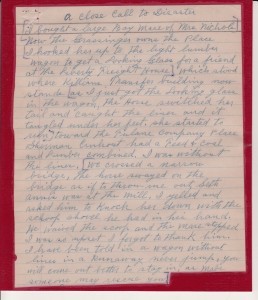 I bought a large bay mare of Mrs. Nichols. I hooked her up to the light lumber wagon to get a looking glass for a friend at the Liberty freight house. As I just got the looking glass in the wagon, the horse switched her tail and caught the lines and they tangled under her feet. She started to run. We crossed a narrow bridge. The horse swayed on the bridge as if to throw me out. Seth Amis was at the mill. I yelled and asked him to knock her down with the scoop shovel he had in his hand. He waved the scoop and the mare stopped. I was so upset I forgot to thank him. I have been told in a wagon without lines in a runaway never jump. You will come out better to stay in, as maybe someone may rescue you.
I bought a large bay mare of Mrs. Nichols. I hooked her up to the light lumber wagon to get a looking glass for a friend at the Liberty freight house. As I just got the looking glass in the wagon, the horse switched her tail and caught the lines and they tangled under her feet. She started to run. We crossed a narrow bridge. The horse swayed on the bridge as if to throw me out. Seth Amis was at the mill. I yelled and asked him to knock her down with the scoop shovel he had in his hand. He waved the scoop and the mare stopped. I was so upset I forgot to thank him. I have been told in a wagon without lines in a runaway never jump. You will come out better to stay in, as maybe someone may rescue you.
With two versions of the story and a little more research so I’d know more about freight houses and wagons and looking glasses, I created a third . . . with one very significant change at the end, and made it into a short story for children. It’s titled, unoriginally, “Runaway.”
Runaway
by
Kathy Lynn Emerson
Freddy spread a heavy blanket over the planks in the back of the light lumber wagon. As soon as it was in place, Father and Douglas loaded the looking glass aboard. They were all very careful. The looking glass was a present for Mother. It had been shipped all the way from New York City.
Freddy folded the blanket over their reflections in the mirror. Douglas tucked in the corners.
“There. All safe,” he said.
They each breathed a sigh of relief.
The freight house doors gaped wide in the October sunlight. Somewhere in the blackness was the freight master’s office.
“I’ll be right back,” Father said. “You two stay here.”
He disappeared inside the building.
Freddy sat down next to the looking glass and glanced around. There wasn’t much to see. The dusty street was empty of people, except for Douglas. Freddy thought that Kit, the horse, was more interesting. She was a big bay mare Father had just bought. She was fidgeting in the traces. She wasn’t used to the wagon yet.
“Easy, Kit,” Freddy whispered. “Calm down, now.”
Kit didn’t listen. Just as Freddy spoke, a piece of paper blew in front of her. The mare switched her tail once and was off. Before Freddy realized what had happened, they were speeding down the hill.
“Runaway!” Douglas yelled.
He made a dive for the tailboard . . . and missed! Freddy was the only one in the wagon as Kit raced away. Douglas was left behind, sprawled in the roadway and covered with dust.
It wasn’t easy to climb forward over the bouncing seat. Somehow Freddy managed it and looked for the reins. The ends should have been tied in place, but they were gone. For the first time, Freddy felt afraid. Kit’s tail had caught the lines. They were dragging along the ground, tangled and far out of reach. There was no way now to stop Kit’s mad flight.
Freddy tried to stay calm. Father had told them once that it was safer to stay put in a runaway than to try to jump out. The wagon swayed dangerously as Kit crossed the narrow bridge at the foot of the hill. Freddy’s eyes widened. The deep, cold water of Shaw’s Creek came very close. Father hadn’t said anything about being thrown out!
In a panic, Freddy scrambled back over the seat and crouched in the bottom of the wagon. The mirror was sliding back and forth across the planks. Freddy tried to steady it and hold on tight to the edge of the seat at the same time. It was tricky.
“Whoa!” Freddy hollered. “Whoa, Kit!”
Kit paid no attention.
By now there were more shouts of “Runaway!” Some men waved their arms at Kit as she raced by them, but they only frightened her more. She sped on toward Bonner’s Mill.
Freddy peered fearfully over the top of the seat and yelled “Whoa, Kit!” again. Ahead, Seth Ames came into sight. He was walking slowly out of the mill, carrying a coal scoop. He didn’t see them coming.
“Mr. Ames! Look out!” Freddy cried.
Seth turned around and saw Kit and the wagon bearing down on him. For a moment, he stood frozen in place. Then, too late, he tried to leap out of the way. The scoop shovel in his hand waved wildly and came down on Kit’s head.
Startled, the horse stumbled and almost fell. The wagon bounced to a halt. Before Kit could run again, Freddy had scrambled out and grabbed her bridle.
“Easy, Kit. Easy, girl.”
Freddy stroked the mare’s nose and kept talking quietly. Kit wasn’t hurt, but she was frightened. Her eyes rolled wildly. She’d just begun to calm down when Father and Douglas came into sight.
“Are you all right?” Father shouted as he ran.
“I’m fine. So’s Kit. And so’s the looking glass.” Miraculously, it hadn’t broken.
Father began to laugh with relief. By the time he reached the wagon, he was shaking his head in amazement. He often did that around Freddy.
“You’re a brave girl, Fredericka,” he said.
So that’s the story, and the story behind the story. After several rejections, “Runaway” was published in 1985 in an obscure children’s magazine distributed to Sunday Schools. I was paid, if I remember correctly, a whopping $7.50 for first rights. It was my second short fiction sale and only the fourth time I’d sold anything I’d written, and most of the credit goes to Grampa Gorton.
Kathy Lynn Emerson/Kaitlyn Dunnett is the author of over fifty books written under several names. She won the Agatha Award for best mystery nonfiction of 2008 for How to Write Killer Historical Mysteries and was an Agatha Award finalist in 2015 in the best mystery short story category for “The Blessing Witch.” Currently she writes the contemporary Liss MacCrimmon Mysteries (Kilt at the Highland Games ~ July 2016) as Kaitlyn and the historical Mistress Jaffrey Mysteries (Murder in the Merchant’s Hall) as Kathy. The latter series is a spin-off from her earlier “Face Down” series and is set in Elizabethan England. Her websites are www.KaitlynDunnett.com and www.KathyLynnEmerson.com
June 3, 2016
Weekend Update: June 4-5, 2016
 Next week at Maine Crime Writers there will be posts by Kaitlyn Dunnett/Kathy Lynn Emerson (Monday), Dorothy Cannell (Tuesday), John Clark (Wednesday), Brenda Buchanan (Thursday), and Susan Vaughan (Friday).
Next week at Maine Crime Writers there will be posts by Kaitlyn Dunnett/Kathy Lynn Emerson (Monday), Dorothy Cannell (Tuesday), John Clark (Wednesday), Brenda Buchanan (Thursday), and Susan Vaughan (Friday).
In the news department, here’s what’s happening with some of us who blog regularly at Maine Crime Writers:
Lea Wait: Busy week! Saturday, June 4, Dorothy Cannell and I and children’s author Melissa Sweet will be signing our books at the Waldoboro Library, Waldoboro, Maine, from 12:30 until 3:30, helping the library celebrate it’s 100th anniversary. There’ll also be music, face painting, games, refreshments … and a good time for all!
 Thursday, June 2, I’ll be speaking with the Mystery Group at White Birch Books in North Conway, New Hampshire about my TWISTED THREADS. In the area? All are welcome.
Thursday, June 2, I’ll be speaking with the Mystery Group at White Birch Books in North Conway, New Hampshire about my TWISTED THREADS. In the area? All are welcome.
Friday, June 3, from 5 p.m. until 7 p.m. my husband and I will be at the opening of the Stable Gallery on Water Street in Damariscotta. His paintings will be featured.
Saturday, June 11, I’ll be at the Guilford Library in Gulford, Maine, from 11 a.m. until 1 p.m., signing my books and chatting informally about mysteries. Stop in if you’re in the area!
An invitation to readers of this blog: Do you have news relating to Maine, Crime, or Writing? We’d love to hear from you. Just comment below to share.
And a reminder: If your library, school, or organization is looking for a speaker, we are often available to talk about the writing process, research, where we get our ideas, and other mysteries of the business. Contact Kate Flora: mailto: kateflora@gmail.com
June 2, 2016
A Ladder for Maine Fish? It’s Alewife Time!

Priscilla McCandless’ painting of the fish ladder and the small community of Damariscotta Mills
Lea Wait here, betting that a lot of you have never heard of either fish ladders or alewives. So – here’s the story. An alewife is a small (8-10 inch long) fish. This time of year, the alewives head up some of the rivers in Maine to spawn.
The Damariscotta River (Damariscotta means “river of many fishes) is one of their ancestral routes. Thousands of alewives swim up the river from the sea, and jump up the falls at Damariscotta Mills to get to the fresh water of Damariscotta Lake. For hundreds of years their annual migration has provided food for gulls, ospreys — and humans living nearby, who dried and salted the little fish. The smallest fish were also used as lobster bait.

Alewives, Heading Up the Falls
But as far back as 1730, humans blocked the migration by constructing a double sawmill on the falls. In 1741 the Massachusetts Legislature (Maine was then a district of Massachusetts) passed an “Act To Prevent the Destruction of Alewives and Other Fish”,
requiring that passage for fish be provided around falls blocked by mills.
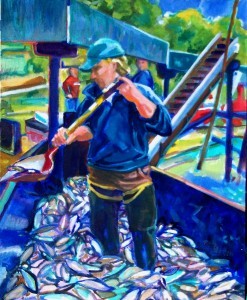
Priscilla McCandless painting – Harvesting Alewives in the old days
In Damariscotta Mills the fall are 42 feet high. At first a local shipowner had his

A view of the Fish Ladder
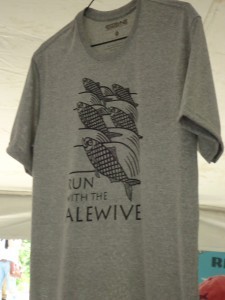
Buy a tee-shirt! Save the alewives!
employees net as many of the thousands of fish as possible and carry them to the lake above the falls. That plan proved ineffectual, at best.
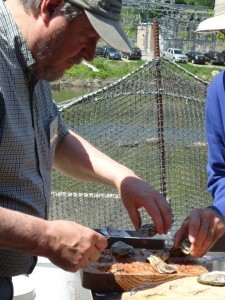
Stephen — he and others shucked over 2,000 oysters during the Festival!ohen
In 1809 the towns of Newcastle and Nobleboro built a lock stream to help the fish climb the falls; it had to be rebuilt every five to ten years.
In 2007 the Fish Committee of Nobleboro and Newcastle initiated a major building project: the construction of a permanent, stone, environmentally safe and attractive “ladder” for the fish. Every year since, over Memorial Day weekend, they sponsor a festival to raise the funds to do this. And every year the “Fish Ladder Restoration Festival” — known locally as the “Alewives Festival” — has gotten larger and raised more money. People from all over the United States have made the Festival (and the sight of thousands of fish heading up the falls) a destination.

Yum! Local oysters!
This year 5 and 10 K runs were added to sales of tee-shirts and hats, food (oysters, beer, lobster and crab rolls, hot dogs, and a pig roast), rides in antique cars and horse-drawn wagons, live music, and, of course, the stars of the show: the alewives. The festival hosted thousands of guests, and raised about $30,000 to contribute to

Waiting Herring gulls, between fish courses
the Fish Ladder Restoration.
My husband and I participated, as we have several other years. Our friends Priscilla McCandless and Stephen Vowles, who live in Damariscotta Mills, are very active in the Festival, as are our Edgecomb neighbors who own Alewives Fabrics, a store near the falls.
You may have missed attending the Festival this year … but the pictures here should give you an idea of how much fun it was! Bob and I devoured oysters and hot dogs, and bought pork sandwiches home to eat for dinner. Yum! Local gulls and ospreys thought the same …
And, best of all, the alewives are, once again, back.
Lea Wait writes the Shadows Antique Print Mystery series and the Mainely Needlepoint series, and five historical novels set in nineteenth century Maine. She’s a fan of all things fish.
Maine’s beautiful, tragic reality: The enemy is us
A summer or two ago, I was standing in line for some food in my small central Maine town when a tourist – I’m not making assumptions, sometimes you can just tell – asked me where she could find a public bathroom. I suggested the porta-potty at the local country store, or the one at the other end of Main Street by the church parking lot.
She was appalled and maybe even a little disgusted. And kind of disdainful.
Sorry, lady. Maine.
When you live here, you learn to accept the lack of facilities, lack of cell service (there are even places in my house I can’t get it), issues related to remoteness – like no open restaurants or bars, or even lack of food or gas stations if you go too far off the track. There’s a hope that if people come up to take advantage of the beauty our state has to offer and stray away from the lobsters and lighthouses, they’ll know that too and be prepared.
As Dylan sang, “If you don’t believe there’s a price for this sweet paradise, just remind me to show you the scars.” He wasn’t singing about Maine, but you get the picture. Nothing this good doesn’t come with some hurt.
Most times, the result is that people who misjudge just how remote or rustic things are in Maine are inconvenienced.
But sometimes it’s worse.
That hit home last week when the Maine Warden Service released it’s 1,500-page sad and tragic report on the disappearance of Geraldine Largay. Largay, 66, disappeared on the Appalachian Trail in western Maine in July 2013. Her remains were found in October 2015, about two miles off the trail in a restricted military area. At the time, the warden service didn’t say much about the circumstances and the focus was on how sad and tragic it was that in one of the most extensive searches in the state’s history, one that had gone on in various forms until she was found by someone who wasn’t looking for her at all, she succumbed to hunger and thirst and died waiting for someone to find her.

Geraldine Largay, seen here the day before she became lost, disappeared off the Appalachian Trail in July 2013. Her remains were found in October 2015 and the Maine Warden Service case file was released last week. (contributed photo)
The report is even more – here are those words again – sad and tragic. As the media, including the newspaper I’m city editor of, the Morning Sentinel, started digging through the case file, the details were sobering. She’d wandered off the trail July 21, 2013, about three hours after texting her husband, who was meeting her two days later where the trail crossed Route 27. When she realized she was lost, she texted him again saying she was lost and asking for help, but he never got it because there was no cell service where she was. She tried again, many times, but none of those texts reached him.
Largay kept a journal with a final entry Aug. 6 asking that her family be notified when her body was found, and a possibly later entry, though the warden service says that date is in question.
As we looked further into the case file at the Morning Sentinel, the tragedy became even more chilling. Buried in all that other information was the fact that Largay didn’t know how to use a compass.
Largay, of Tennessee, had started hiking the second half of the trail in Harpers Ferry, West Virginia. She’d gone about 950 miles and had less than 200 to go. A friend had accompanied her, but had to leave as they finished the trail in New Hampshire. And Largay was alone.
When she was lost, again when her remains were found and again after the news from the report began making headlines last week, the warden service and her family said she was an experienced hiker. But her friend, in the report, also said she had increasingly become more disoriented on the trail and was prone to panic. She didn’t like being alone and didn’t like the dark. She’d been prescribed anti-anxiety medication, but no one knew if she’d been carrying with her or was able to renew the prescription.
She’d had a SPOT device – a GPS that can be used instead of a compass – but according to the report had left it behind in a hotel. She had a compass, but according to the report, didn’t know how to use it.
Her husband was meeting her at checkpoints every few days and they were relying on texting to keep in touch.

The Appalachian Trail near it’s end at Mount Katahdin in Baxter State Park. Geraldine Largay was less than 200 miles from her destination when she became lost.
Yes, Largay was experienced – she’d hiked hundreds of miles on the Appalachian Trail, had taken a course before her hike, had hiked before. But she was entering what’s considered the most challenging part of the trail. A place she couldn’t expect to get cell service. A place where the woods can eat up a person in minutes. A place where some of the most experienced searchers in the world couldn’t find her, despite coming as close as 100 yards of her resting place with a dog tracking team.
She was alone. She was prone to getting disoriented. She didn’t know how to use a compass.
The Morning Sentinel has written numerous stories, including the ones on Largay, where locals stress how many underestimate Maine – its remoteness, its wildness. Many of the conveniences we rely on in other places just don’t work or help here.
There’s a kind of joke among Maine mystery writers that despite the fact the state has one of the lowest crime rates in the country – we get about 20 to 25 homicides a year – we certainly kill off a lot of people in our books. I was just thinking about that yesterday, as we reported on the state’s sixth homicide of the year, a fatal shooting in Wilton, also in Franklin County south of where Largay got lost. I think between Cold Hard News and its soon-to-be released sequel, No News is Bad News, I’ve killed off that many people in less than a year. In one town with a population of about 2,000.
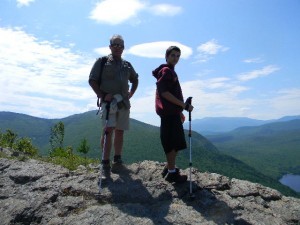
My brother Bill and nephew Tim hiking in Baxter State Park. Maine is beautiful, but unforgiving. It’s up to us to know that.
What we forget is that the biggest threat to life in Maine is Maine itself. This doesn’t mean the state and its wilderness is evil or bad – English and philosophy majors will recall the school of Naturalism, the belief that nature is in charge and what it says goes. Free will? It’s a joke. We have no control. It’s indifferent to puny humans and we think we can conquer it at our own risk. At least that’s how I remember it. Writers including Edith Wharton, John Steinbeck and Stephen Crane were big believers. One of the biggest was the great Jack London, whose “To Build a Fire” is Largayesque in its tragedy.
None of this is a knock on Geraldine Largay or her family or the warden service.
But please remember this if you’re going for a day hike, even in the lobster and lighthouse district, or out in the wilderness, in Maine, or anywhere:
She got off the trail and became disoriented. She didn’t know how to use a compass. Her cellphone didn’t work.
The people most qualified to find her couldn’t as she lay dying from lack of food and water in her tent about two miles off the trail in Franklin County, Maine.
——-
Maureen will be one of the featured authors at Maine Author Day at the Guilford, Maine, Memorial Library, 11 a.m. to 1 p.m., Saturday, June 11. Come on by and say hi! Books will be available for sale and signing.
——-
Maureen Milliken is the author of the Bernie O’Dea mystery series and city editor of the Morning Sentinel in Waterville, Maine. Follow her on Twitter: @mmmilliken47, on Facebook: Maureen Milliken mysteries, and sign up for web updates or find out about her latest book at maureenmilliken.com.
May 31, 2016
Keeping a Series Character Alive
I recently came across a tweet from Lawrence Block praising John Sandford’s most recent release in the Prey series, a fine police procedural set in and around Minneapolis. With my usual grace for social media, I’ve lost the tweet itself but the essence of Block’s praise was his sense that Extreme Prey (the 26th in the series!) continues to draw and entertain new readers because of the way Sandford has developed and extended his protagonist over that time.
continues to draw and entertain new readers because of the way Sandford has developed and extended his protagonist over that time.
Lucas Davenport might be one of the most fully-realized series character in contemporary crime fiction. His professional roles through the course of the Prey books alone would be enough to ensure a level of interest. He’s been a patrolman, a detective, then a deputy chief with the Minneapolis police department, fired from all of those positions, rehired into vague investigatory slots. He’s been a civilian contractor with the New York PD and the chief of the Minnesota Bureau of Criminal Apprehension. Between jobs, he winds up in barely-defined political troubleshooting roles for various local and national politicians, including the governor of Minnesota. On top of that, he’s been a game designer, a businessman, and he’s rich enough that he doesn’t even have to work. Or take any crap from the bureaucracy.
The chief challenge for a crime writer creating a series character is keeping him or her fresh and interesting over multiple books, revealing enough to engage the reader without overdoing the backstory and overwhelming the reader, who is reading your book for the story too. Consider your own favorite series character who’s survived 5 or 6 books and I’m sure you can point to examples where the character gets—well, if not boring, a touch predictable. 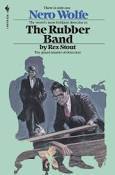 After a while, Nero Wolfe’s orchids and beer consumption become less about the character than a convenient shorthand for him, a kind of template.
After a while, Nero Wolfe’s orchids and beer consumption become less about the character than a convenient shorthand for him, a kind of template.
The temptation for a writer (because we writers always have to make ourselves do the hard things) is to let the markers stand in for the characters, instead of developing the character more deeply. I see this in some of the late Parker-written Spenser novels—Spenser’s modes, attitudes, solutions, and repartee haven’t moved all that far from those in The Godwulf Manuscript, the very first in the series.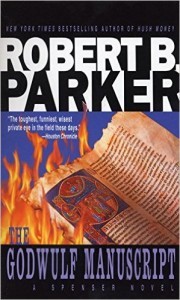
As a writer interested in a long and happy life for Elder Darrow, the protagonist in
Solo Act, I’m always trying to figure out what makes a protagonist so interesting that I will even go back and read books I know, just to spend time with the character. I just read Extreme Prey myself and while Lucas Davenport is recognizable both physically and psychologically, he has not staled. Here are some of the reason why:
He owns a rich and varied backstory, starting from the very first book, including stories about childhood friends like Elle Krueger (who appear later as a significant character), about his college hockey-playing days, his roots, and his history with the city of Minneapolis. As the series progresses, the backstory grows to include lovers, an out-of-wedlock child, a near-feral girl whom he rescues and winds up taking as a ward; and Weather, his now-wife, who in an early book saves his life with an emergency tracheotomy. Various partners, friends, and thugs come and go. But the backstory is only presented in places where the story requires it. Sandford does a fine job making these events and people appear naturally over course of the series, as they would be over a life.
Davenport also carries a set of characteristics, physical and psychological, that both identify him and challenge him in every book. He has his scars, of course, but he has a propensity for violence, for rage, a certain vanity about his clothes, an inability to get along with any form of command structure for long. But these are not markers, not only descriptive bits. They work with the plot and Davenport’s character, sometimes to his benefit, sometimes not. They are characteristics, not identifiers.
What makes him believable for me, then, is the full sense of a life lived, as it is being lived. What is front story in one book becomes back story in the next, adding layers of complexity and humanity to the character. His attitudes change—he becomes more politically savvy, spends less time indulging his lustful eye. Friends and colleagues change, get sick, die.
All this suggest something I’ve heard a lot as a writer but maybe never internalized as much as I need to. When you first create a character, especially a series character, you need to know him or her as well as yourself. Before you write the first book you need to know as much as you can. Much of what you know will never appear on the pages but the knowledge will inform the character as you tell his or her story and affect how the plot works with and on the character. And, of course, if you are lucky enough to create and maintain that deep relationship, you may even create a character that endures. Sherlock, anyone? Miss Marple? Travis McGee?
A Mostly True, Sorta Tale of Guyishness, Minus the Bullet Holes and Duct Tape
John Clark is unavailable today as he’s in Rapid City, SD at the Elmo Ermwood Institute for an annual spiritual oil change and alignment. He will return for his next regularly scheduled post. His favorite cousin, Pradesh ‘Bubba’ Letourneau is posting instead about John’s history with “Guy” mishaps.
I was sittin’ on the back porch swing when John stumbled around the corner, wincing visibly as his tailbone met the seat beside me. “Need a refresher, Boy?”
He nodded.
“The usual?”
“Yup.”
When I returned and handed him a can of diet cherry soda, he mumbled thanks, popped the top and killed half in one continuous gulp. “Thanks, I needed that. I been dragging so much the past couple weeks, I gotta stop and pull dandelions outta by backside before Ma will let me in the house.”

Some stuff got done despite the log attack, like the grapevine revamp.
“Don’t tell me. You gone back to doin’ them dumb guy things again. I thought you outgrew them ’bout twenty years ago.”
“So did I, but when you’re a writer, sometimes you gotta experiment to get a handle on realism, ya know.”
“Do tell. Lemme see, then. Does that mean the Roto-Rooter man’s gotta go sewer pipe divin’ if he wants to get real good at his job?”
John winced. “Don’t make me laugh, that hurts almost as bad as sneezing right now. How else was I gonna learn that duct tape ain’t worth a damn when it comes to fixing bullet holes, but sterile tent caterpillar silk and super glue work slick as a smelt.”

We have plenty of extra Hosta as well as Calendulas, if anyone is interested.
“Cripes, Bubby, you didn’t shoot yourself just to see how it felt did you? I could see doin’ some serious experimenting if you was writin’ them bodice rippers, but hands-on mayhem don’t seem particularly appealin’ to me.” Besides I’d think you’d have enough hands and body-on experience already to rely on.
“Lemme see, there’s the broken foot when you got it caught in the spokes on your bike, the near ruptured appendix and that sadistic nurse who came in every twenty minutes to make you laugh, the cat that darn near scratched your eye out, the tree ya dropped on the power line, the chip ya took in your eye when you was too stubborn to wear safety goggles.”
“You can stop any time now.” John was fighting a grin as I reeled off his lifetime of mishaps.
“Ain’t happening. I’m just getting’ to the good stuff like runnin’ into that elm tree on a borrowed motorcycle, then compounding injury and insult by showering with the cast still setting AND then trying to use a scythe to cut brush the next day up on Appleton Ridge. How about the cigarette that burned your finger down to the bone on our class trip? Dare I mention drivin’ your dinky station wagoninto Chickawaukee Lake while blitzed? I’ll grant that ya slowed down after coming to your senses, but there’s a couple real good chainsaw bites like the one on your kneecap and the time you tried bucksawin’ and talking at the same time. I bet that scar’s still visible unlike the stitches ya popped when tryin’ to plant trees the day after hernia surgery.”
My cousin had the grace to blush when I paused. Truth be told, if he wanted to, John coulda come up with almost as many guy-haps on my part if he wanted to. I decided I’d better finish the list quick. “Lemme see, what did I forget? Oh, yeah, the finger. Come to think of it, that might have been the best and last one I remember. It takes a real idiot to drop a three hundred pound rock on their pinkie, split it to the first joint and try to convince their RN wife that a bandage was gonna do the trick. How many stitches did it take?” I was rewarded by a two middle finger salute.
“So, Bubby, what happened this time?” I waited while John killed the rest of his soda.
“Well, a couple weeks ago, I got real ambitious about pruning apple trees, seeing as how I’m retired and have time to really get on top of projects. Since that damn ethanol dissolved the fuel line in my chainsaw and I sorta haven’t gotten around to hauling it up to Harmony to get it fixed, I used my hand pruning saw to do the job. However, that left some hellaciously big limbs to buck up and doing so with the pruning saw gets old real quick, so one Sunday I strung all my extension cords together and started cutting the four big limbs into stuff that Sara and Russ can burn in their stove. I was using my electric pruning saw which, by the way is one of my best buys ever. The biggest limb was Y-shaped and about 12 feet long. I’d just sawed through a chunk that was about head high, when the rest of it jumped forward. The cut end smacked me square in the chest and I swear, I knew how Sonny Liston must have felt when Cassius Clay hit him in the Lewiston Fight. It was instant numbness, followed by the thought that maybe my heart might stop and then serious hurt. Of course real guys don’t stop to assess damage, they finish the job, so I kept cutting, then stacked everything before daring to lift my t-shirt and see how bad it was. Sure enough, there was a big red half circle of ugly and lots of unhappy ribs.

Put ’em together and whatta ya got? A real rib killer.
“That was what led to my dragging. Still doing so and my ribs aren’t in a very forgiving mood.” John gave me a pained grin. “That stuff about the duct tape, bullet hole and caterpillar silk packing was all thrown in for effect, but I bet I could do a half decent job of using them in a story down the road.”
May 30, 2016
Letters from the Civil War
Hi. Barb here.
When I realized my posting day was Memorial Day, I was a bit flummoxed. There are several people here on the blog who are better equipped to remark on this day than I am.
My father served in Korea, and my grandfather in World War I, and preparing to write this post sent me on a mad scramble to find a photo of either of them in uniform. I didn’t find any, and neither of them were the type to speak about their service. (And since my grandfather was a stockbroker, which meant he made his living on the phone, which meant he would talk your ear off about pretty much anything, the silence speaks volumes.)
But while I was looking, I did find something I hadn’t examined in ages, decades certainly–my great-great-grandfather’s letters from the Civil War.
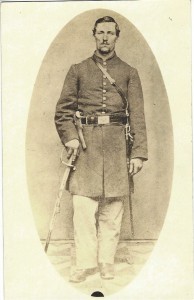
my great-great grandfather, Adoniram Judson Dickison (My brother has the sword)
I was almost afraid to look at them. I thought they might have crumbled to dust, but all but two are fairly well preserved. There are seven in all, written between January 19, 1864 and February 17, 1865 to a niece, Francis Alice Rozelle, back in Oswego, New York. Ancestry.com helpfully tells me that Alice would have been thirteen and fourteen at the time (though I haven’t yet figured out quite how they were related). A. Judson, as he is always called, repeatedly tells Alice that her handwriting is excellent and to stay in school as long as she can. Her side of the correspondence does not survive.
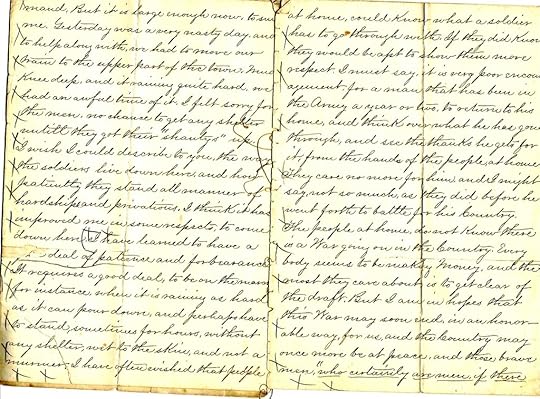 January 19th, 1864, Culpepper, VA
January 19th, 1864, Culpepper, VA
“Yesterday was a very nasty day, and to help along with, we had to move our train to the upper part of the town. Mud knee deep and raining quite hard, we had an awful time of it. I felt sorry for the men. No chance to get any shelter until they got their “shantys” up. I wish I could describe to you the way the soldiers live down here and how patiently they stand all manner of hardships and privations. I think it has improved me in some respects to come down here. I have learned to have a good deal of patience and forbearance. It requires a good deal to be on the march, for insistence, when it is raining as hard as it can pour down, and perhaps have to stand for hours without any shelter, wet to the skin, and not a murmur. I have often wished that people at home could know what a soldier has to go through with. If they did know, they would be apt to show them more respect.”
November 6th, 1864, Yellow House, VA
[The part at the top about his wife Sarah having bought a baby girl threw me for a bit of a loop, until I realized from other letters when his last leave had been. I don’t know if he is shielding a young girl from the realities of conception and birth, or if he is joking. The baby would have been my grandfather’s beloved Aunt Clara. She and her husband–childless themselves–paid for my grandfather to go to Columbia University after he came home from World War I.]
“You ask me what I think of this War. I think it is pretty near its end. We all think here in the Army that the Rebs are pretty well used up and there are very few but what think that the re-election of Lincoln will go a long way to closing up the War than anything that can be done just at present. All they are holding out now for is the hope that McClellan may be elected by which they hope to get better terms for Peace. But I think Lincoln’s re-election almost as certain as that the sun will rise to-morrow morning. How anyone who is not a traitor to their country could cast their vote for McClellan and the Chicago Platforms, I can not see.”
February 17th, 1865
“Our Campaign lasted six days, and suffice to say, we had a very nasty time of it. We got into a fight, and our Corps lost 100 killed and 900 wounded and about as many more missing and taken prisoners.”
The letters are fascinating and alternate between the harrowing (he casually mentions he has been taken prisoner “again” and has escaped “again.”) and the homely. He pines for letters from his wife, worries about money (his wife has had to borrow from relatives while he tries to sell a piece of property and waits to be paid) and writes frequently about the weather both where he is and at home in New York.
I do remember my grandfather, in his eighties, lamenting that he’d never asked his grandfather more about the Civil War. A boy of the 1890s, he was far more interested in cowboys and ranches. And here I am lamenting never talking to my father or grandfather about their service. Which goes to show something, I guess. Perhaps that people never change.
May 27, 2016
Weekend Update: May 28-29, 2016
 Next week at Maine Crime Writers there will be posts by Barb Ross (Monday), John Clark (Tuesday), Dick Cass (Wednesday), Maureen Milliken (Thursday), and Lea Wait (Friday).
Next week at Maine Crime Writers there will be posts by Barb Ross (Monday), John Clark (Tuesday), Dick Cass (Wednesday), Maureen Milliken (Thursday), and Lea Wait (Friday).
Keep your comments coming this weekend. Another bag of Maine books and goodies will go to one lucky person who reads and reacts to our May blog posts.
In the news department, here’s what’s happening with some of us who blog regularly at Maine Crime Writers:
from Kaitlyn Dunnett: I’m doing a Goodreads giveaway of ten advance reading copies of the tenth Liss MacCrimmon mystery, Kilt at the Highland Games. Here’s the link: Goodreads giveaway but you’ll have to wait until Monday, May 30, to enter. The giveaway will remain open until Friday, June 17.
from Bruce Robert Coffin: Sisters in Crime presents: Breaking into Crime Fiction, Thursday, June 2nd at 7 pm at the Public Library in Leominster, Massachusetts. I’ll be joined by literary agent Paula Munier from Talcott Notch Literary and author C. Michele Dorsey, as we discuss the road to publication. Books will be available for purchase and signing. We’d love to see you there!
from Lea Wait: Writers love libraries! Saturday, June 4, I’ll be one of the authors celebrating the 100th anniversary of the Waldoboro Library, in Waldoboro, Maine. I’ll be signing my books there from 12:30 until 3:30.
from Kate Flora: My co-writer, Roger Guay, and I will (and possibly a clever K9) will be at the Bridgton Library, 1 Church Street in Bridgton, at 2:00 on Tuesday, June 7th, to talk about A Good Man with a Dog.
from Barb Ross: Friday, June 3, 2016, 11:30 am to 3:00 pm, I’ll be speaking and signing at the Wolfeboro N.H. Friends of the Library Book and Author Luncheon at the Bald Peak Colony Club inMoultonborough, NH. Tickets must be purchased in advance.
An invitation to readers of this blog: Do you have news relating to Maine, Crime, or Writing? We’d love to hear from you. Just comment below to share.
And a reminder: If your library, school, or organization is looking for a speaker, we are often available to talk about the writing process, research, where we get our ideas, and other mysteries of the business. Contact Kate Flora: mailto: kateflora@gmail.com


